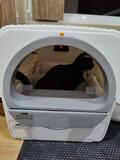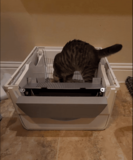Training a cat to use a litter box can be straightforward, whether you're working with a kitten or an adult cat. While it may take a bit longer for older cats to learn, the process is very similar for all ages. Here’s a comprehensive guide to help you successfully litter train your cat.
Step 1: Gather Supplies
Before starting the training, make sure you have all the necessary supplies:
- Litter Box: Choose one based on your cat's size and preferences. Avoid covered boxes if your cat feels threatened and opt for boxes with low sides for older cats.
- Cat Litter: Different cats have different preferences. Some may prefer clumping litter, while others might like non-clumping. Test to find out which your cat prefers.
- Litter Scoop: A sifting scoop is convenient for daily cleaning.
- Cleaning Supplies: Use pet-safe cleaners for weekly deep cleans and enzymatic cleaners for accidents.
- Disposable Gloves: For hygienic handling of cat waste.
- Garbage Bags: For easy disposal of used litter.
- Unscented Dish Soap: For cleaning the litter box.
Step 2: Set Up the Litter Box
Proper Placement: Place the litter box in a quiet, low-traffic area where your cat can feel safe and undisturbed. Ensure it's far from their food and water bowls, as cats prefer not to eliminate near where they eat.
Fill the Box: Cover the bottom of the box with about 2 inches of litter. Cats like to dig and cover their waste, so provide enough litter for this. If your cat has a habit of digging and kicking, you might need to use 4 to 5 inches to ensure sufficient litter remains in the box.
Multiple Boxes: For households with multiple cats, provide one litter box per cat plus one extra. Older or less mobile cats might need additional boxes placed in convenient locations.
Step 3: Introduce Your Cat to the Litter Box
Introduction: Gently place your cat in the litter box and let them explore. Do this after naps, eating, or drinking, as these are times they are likely to need the toilet. Allow your cat to dig and get used to the litter.
Repetition: Continue placing your cat in the litter box several times a day, especially after meals. Kittens, in particular, will need to go almost immediately after eating. If you catch your cat in the act of eliminating elsewhere, interrupt them gently and take them to the litter box.
Restricted Area: Initially, confine your cat to a smaller area with the litter box until they reliably use it. Gradually increase their access to more areas of the house as they become consistent in their litter box use.
Step 4: Positive Reinforcement
Reward Good Behavior: When your cat uses the litter box, reward them with praise and a treat. This positive reinforcement helps them associate the box with good outcomes.
Avoid Punishment: Never scold or punish your cat for accidents. This can make them fear the litter box or you. Instead, clean accidents with an enzymatic cleaner to remove the scent and discourage repeat offenses.
Step 5: Adjust as Needed
Move the Box: If your cat isn’t using the litter box, try moving it to a different location or changing the type of litter. Cats can be particular about their environment, and a simple change might make a big difference.
Health Check: If your cat consistently avoids the litter box, consult a vet to rule out any medical issues such as urinary tract infections or cystitis.
Maintaining a Clean Litter Box
Daily Scooping: Scoop out waste at least once a day. This keeps the box clean and reduces odor, making it more inviting for your cat. Use a sifting scoop to remove clumps and solid waste efficiently.
Weekly Cleaning: Perform a thorough cleaning once a week. Empty the litter, clean the box with a pet-safe cleaner, and refill with fresh litter. This helps prevent the build-up of bacteria that can cause urinary tract infections. Ensure the box is completely dry before adding new litter to avoid clumping issues.
Top Off Litter: After scooping, add fresh litter as needed to maintain the proper depth. Cats prefer a consistent and comfortable amount of litter to dig and cover their waste.
Hygiene Tips: Always wear disposable gloves when handling the litter box and dispose of waste in sealed garbage bags. Regularly wash your hands after cleaning the litter box to prevent any potential health risks.
Dealing with Challenges
Accidents: If your cat has an accident, clean it up calmly with an enzymatic cleaner to eliminate the odor completely. This prevents your cat from being attracted to the same spot again. Avoid using ammonia-based cleaners as they can smell similar to urine and may attract your cat back to the same spot.
Behavioral Issues: Sometimes, litter box avoidance is due to behavioral issues. Stress, changes in the household, or even new pets can cause your cat to act out. Try to identify and mitigate any sources of stress in your cat’s environment.
Health Concerns: If your cat consistently avoids the litter box, consult a vet to rule out any medical issues such as urinary tract infections or cystitis. Pain or discomfort can make a cat associate the litter box with negative experiences.
Training your cat to use a litter box requires patience and consistency. By following these steps and maintaining a clean environment, your cat can become a litter box pro in no time, ensuring a happier and healthier home for both of you.









